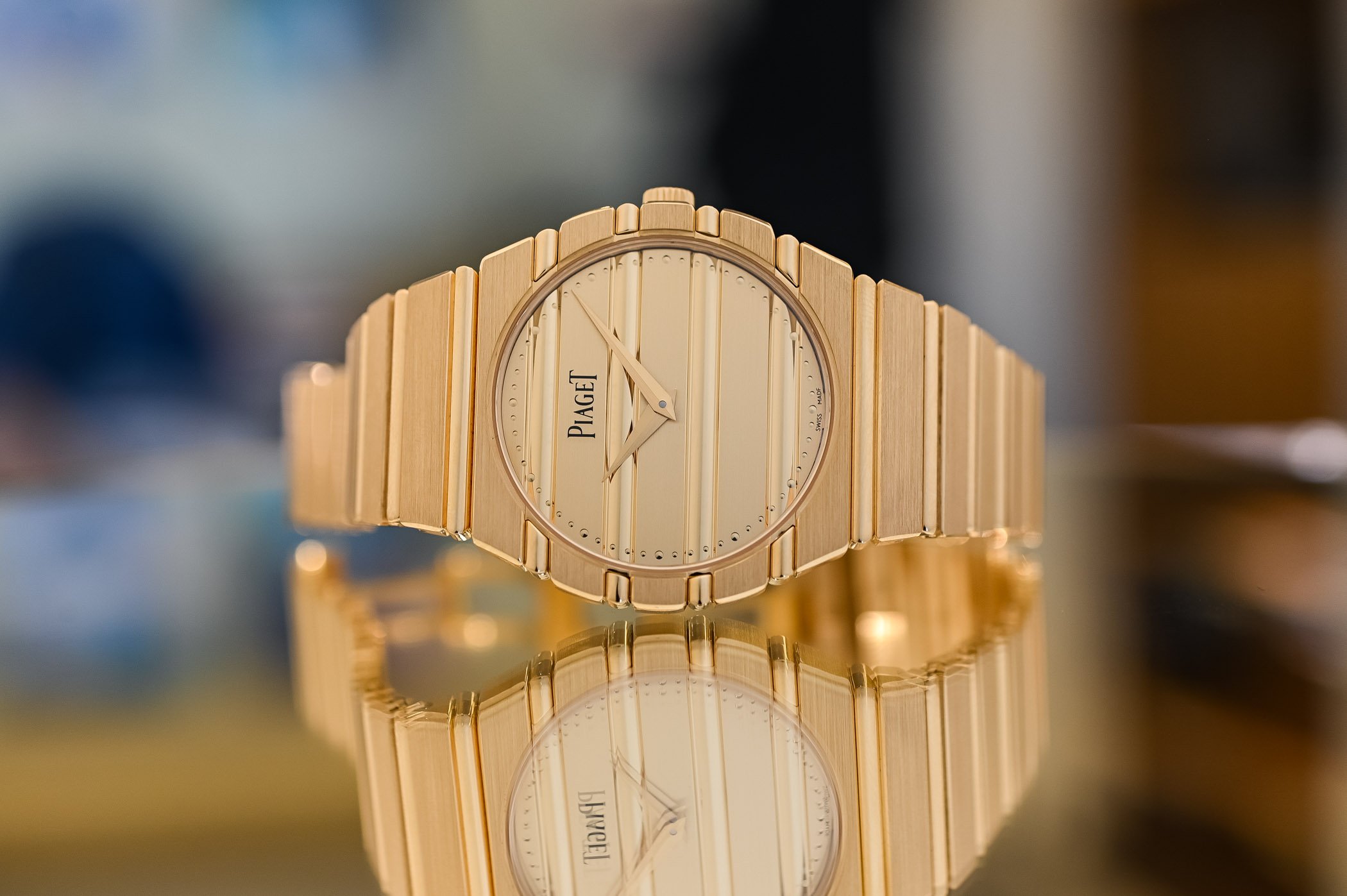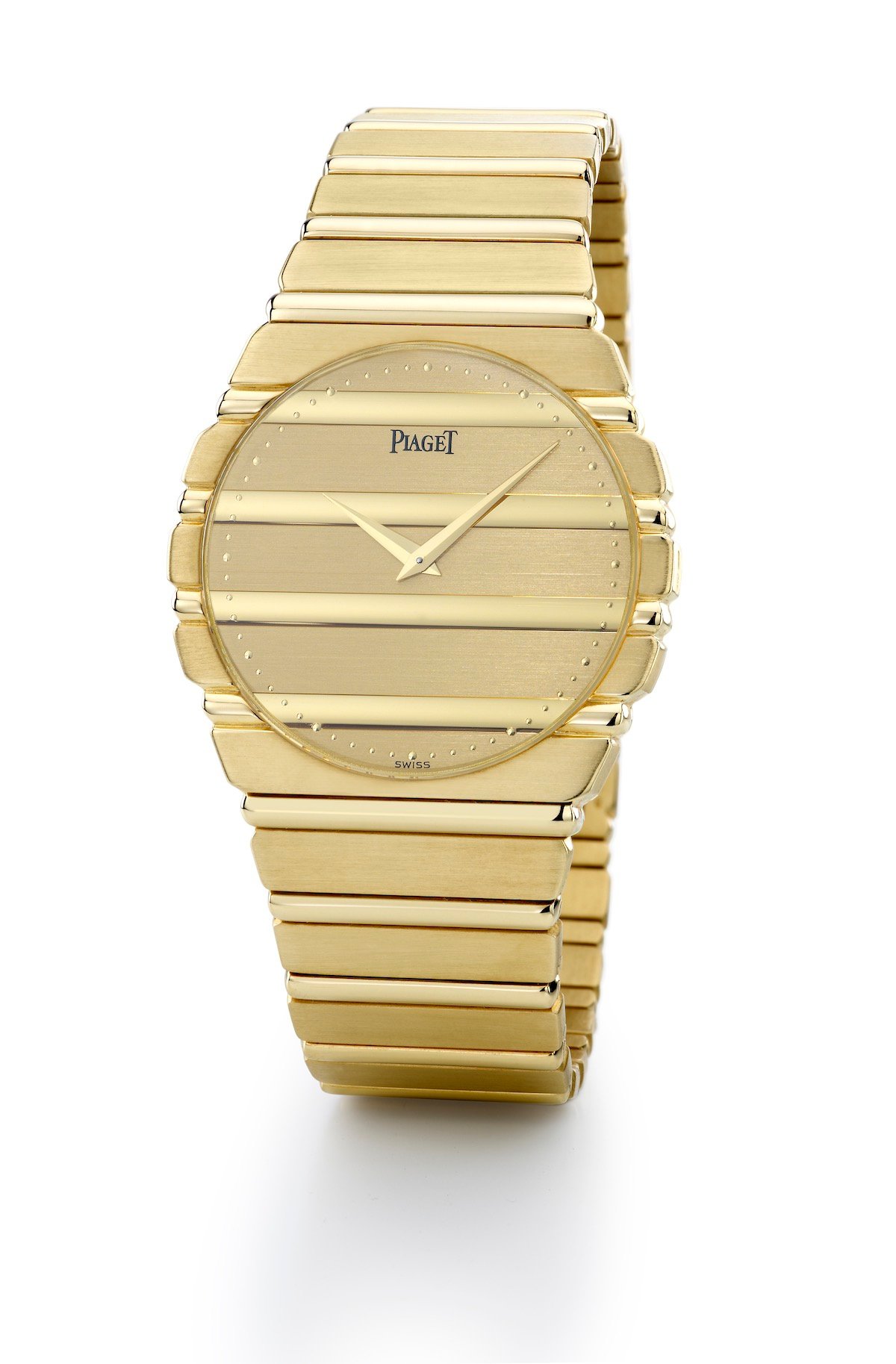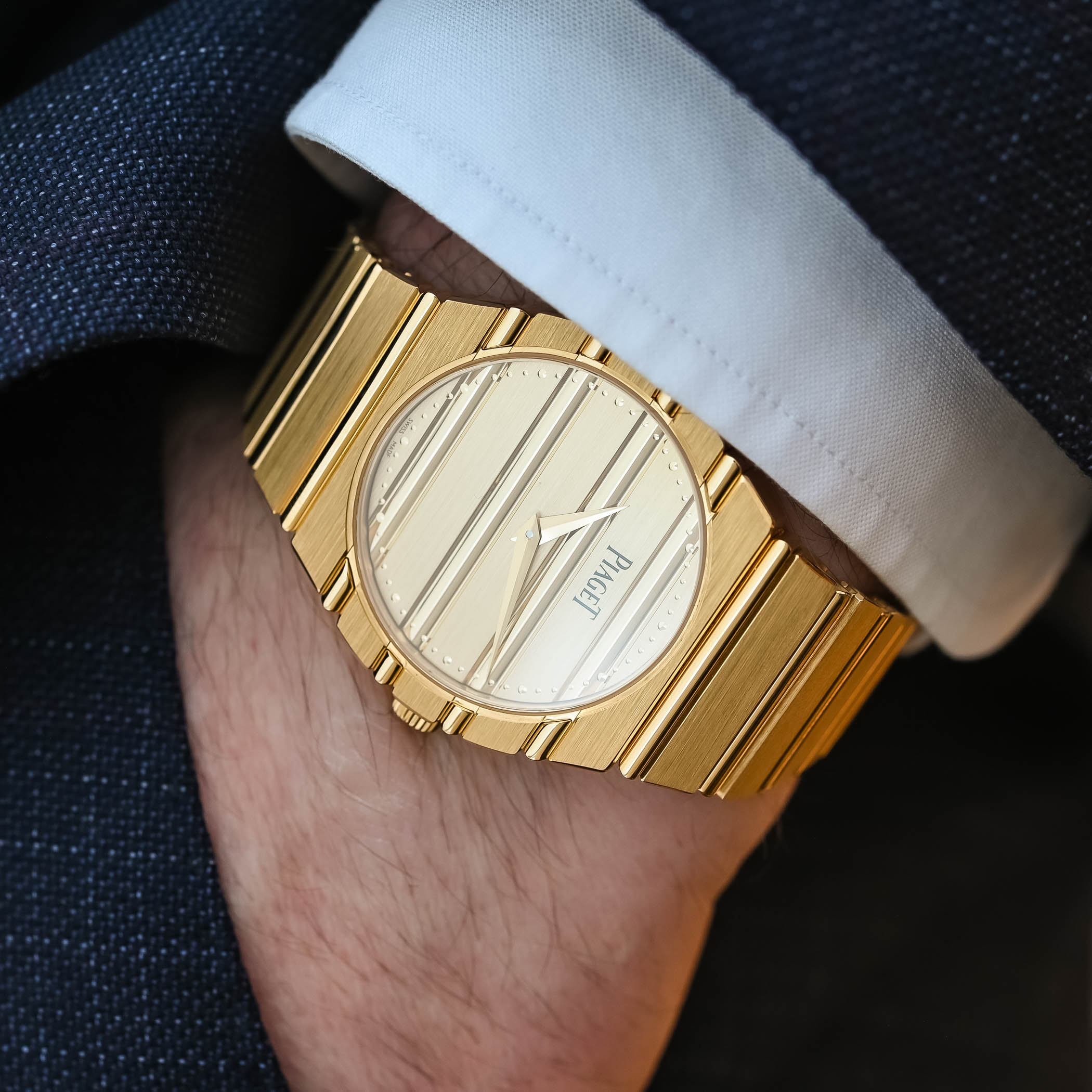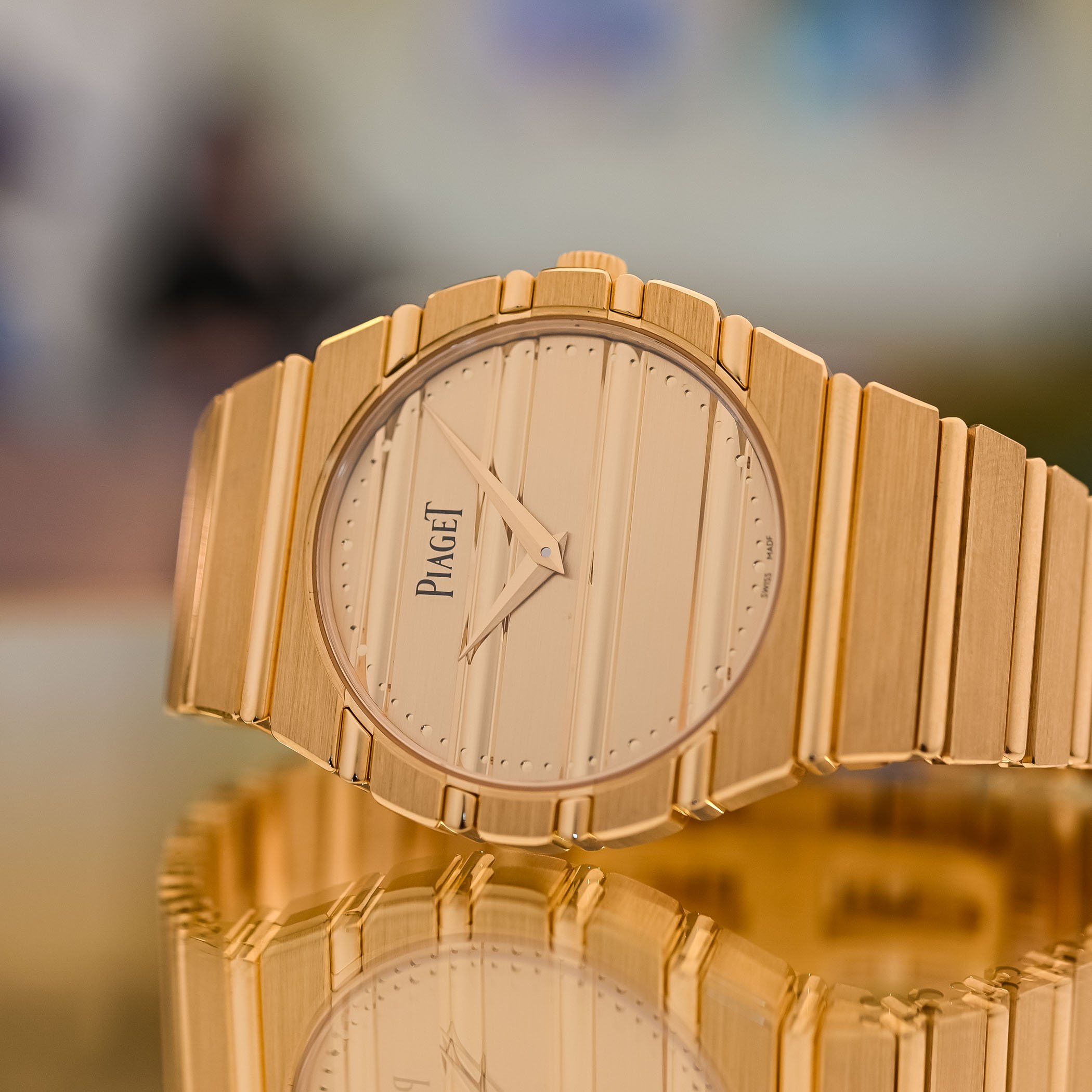The Piaget Polo 79 Recovers its Original Design and Opulent Gold Attire
Forty-five years after the initial shock of its launch, the Piaget Polo returns to its original shape, now powered by an ultra-thin automatic movement.

When it was relaunched with a modernized and sleeker design in 2016, the Piaget Polo adopted the design cues of luxury sports watches, slightly changing the face of the collection to become a cushion-shaped watch. However, this isn’t how the model started its life. This year, Piaget celebrates its 150th anniversary, and to whet our appetite, the brand brings back the unmistakable, opulent, equestrian chic of the original Piaget Polo. An integrated design with its trademark gadroons, it returns in late- 1970s full-gold attire. But if the inspiration is classic, this new Polo has been contemporarily reimagined, starting with its automatic ultra-thin movement. Here’s the new Piaget Polo 79.
Background
“We really had to answer to this particular demand of our customers who are used to getting just dress watches,” explained Yves Piaget at the time. “But now our customers like to do more and more sports. That’s part of the evolution of our lives today. They want to be exquisite, even in sports. They want to wear a better watch, even in their sports. So, we created this sports line which is waterproof, shockproof.”

The 1970s had witnessed the arrival of several elegant sports watches, mostly in steel, launched by some of the grandest names of Swiss watchmaking. The steel luxury sports watch with integrated bracelet revolutionized watch design and the perception collectors had of a high-end watch. Defined by Audemars Piguet and Gerald Genta with the Royal Oak in 1972, the idea was to combine the practicality and resistance of a stainless steel watch, a consistent design between the case and the bracelet, a casual attire and yet the beauty of an ultra-thin, haute horlogerie movement. This watch profoundly influenced the industry, impacting the style of other brands and creating an entirely new category. At Piaget, things went differently… A conversation between Yves Piaget and Efraim Grinberg (then the distributor of Piaget in New York) in 1979 gave birth to a watch like no other in the category, the Piaget Polo.
The Piaget Polo was not just another integrated sports watch. Whether rectangular or round, what made the Polo stand apart was how a series of horizontal gadroons created a distinctive ribbed pattern from the bracelet to the case extending to the dial. As such, it is Piaget through and through, with that distinctive perception of luxury and flamboyance. Additionally, if the 1970s sports watches were mainly available in steel, the Polo was crafted entirely in gold, capturing the purest spirit of the jeweller-watchmaker.
Like many watches during the late 1970s, the Piaget Polo was born with a quartz movement, which could be seen as a natural choice back then. At that time, quartz was popular for being a technological breakthrough, allowing brands to produce watches that were more accurate than anything else before. Piaget had several milestones in the field. The brand was one of the pioneers of this new technology, being part of the consortium of Swiss brands that created the first prototype quartz wristwatch in 1966 with the Beta 21 movement. It is around the evolution of this movement – the Beta 22 – that the cushion-shaped model worn by Andy Warhol in the 1970s was created. However, the Beta movements were relatively thick, and the Polo was fitted with another movement, the calibre 7P, which was introduced in 1976, back then the world’s thinnest quartz movement.
The Polo was a huge commercial success for the brand and made it to the wrists of the jet set and celebrities, including Ursula Andress. The line was discontinued in the late 1980s before making a comeback in 2001 in a modernized version. More recently, the evolution launched in 2016 features a cushion-shaped case reminiscent of the Emperador line.
The Piaget Polo 79
With the Polo 79, Piaget returns to the purest expression of the original round version of the 1979 design. This new, bold, flamboyant watch is a faithful nod to the gold watch born 45 years ago. But as a modern reissue of the historic model, it comes with updates in line with current tastes and modern technical solutions.
To begin with, the proportions of the Piaget Polo 79 meet current trends with a 38mm diameter that will fit most wrists. While it is elegantly compact, the watch is slightly thicker at 7.45mm since a mechanical movement replaces the quartz calibre. Just like in the late 1970s, it is released in full gold. We now have a case and bracelet made of 3N 18k yellow gold, a warmer hue of gold. The water-resistance rating is 50m. The construction of the case itself is quite complex, with the polished gadroons added later to a hollowed brushed case to create a consistent assembly of gold.
The display back of this new Polo 79 reveals the extra-thin automatic Piaget calibre 1200P1. A faithful heir to the emblematic automatic calibre 12P, this movement has a diameter of 29.9mm with a height of just 2.35mm. It is wound by an off-centered micro-rotor, it beats at 3Hz and it boasts 44h of power reserve when fully wound. It is nicely finished with a circular-grained plate, bevelled bridges with circular Geneva stripes, sunburst-brushed wheels and blued screws.
The trademark gadroons continue as one’s gaze drifts to the dial, creating a visual continuity that ties the entire watch together. Fashioned out of gold, just like the case and bracelet, this dial features a tone-on-tone minute track with pearl-like dots of varying sizes, creating animation. The elegant dauphine-style hands are made out of 18k gold, too.
The bracelet seamlessly integrates into the case and alternates polished gadroons and satin-brushed flat surfaces, creating eye-catching reflections. It is also highly tactile and flexible, with a real sense of fluidity. If the bracelet looks similar to the original model, it has, like the case, been modernized. It is also superbly executed with great attention to detail and beautifully finished. The “backbone” effect (with screws to assemble/disassemble the bracelet) on the inner side underlines its sophisticated, robust construction. It is closed by a triple-blade folding clasp (without micro-adjustment) versus a ladder clasp for the historical Polo.
The Piaget Polo 79 is a genuinely appealing, intentionally extravagant yet coherent watch. Its style speaks for itself, and the overall execution is undeniably beautiful. The watch has a strong presence on the wrist and all the heft you expect from a gold bracelet watch. And if the choice of gold makes perfect sense in this historical context, I would be really curious to see versions in other materials. It is released as part of the permanent collection, and if it isn’t a limited edition per se, it will be limited in production. It will be priced at EUR 80,000.
For more information, please visit www.piaget.com.

















6 responses
The name on the dial is way too big.
Fantastic watch from aestetics perspective. But how the hell did they come to this 80k price??? ok, it is like 200 gramms of gold – 10K, movement – 2K, saph glass -1K, work of watchmakers – 10 or even 20K MAX. but thats not even close to 40K…
As has been pointed out elsewhere, the display back gives a very fine view of the standard, off the shelf, ETAchron regulator assembly – on a watch costing EUR 80k. Don’t get me wrong, the ETAchron system is reasonably rugged and well tested, and just fine on an ETA 2824 or 2892, but surely NOT on a watch pitched at 80k?
I just don’t get the pricing. It’s nearly double the price of the competition. For example the Bulgari Octo Finissimo in full gold (probably the closest thing on the market) is €49,000. Rolex Day-Date in full yellow or rose gold is about £30k GBP (not sure of Euro prices). Even an AP Royal Oak 15510 in full gold is €67,000 and that’s with the hype and brand name recognition, plus it’s a substantially heftier piece. Are they really expecting people to pay this, or is it more of a halo piece that’s designed to improve the brand image rather than actually selling?
Exclusivity is what you get for that extra $40K
At this point watch companies are just fleecing the public with these prices. How much does that brushed gold Bulgari octo finissimo extra thin cost?